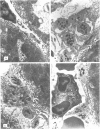Abstract
1. Injection of lipopolysaccharide (LPS; 0.5-500 microgram kg-1) into mice induced a dose-dependent, slowly developing increase in hepatic content of 5-hydroxytryptamine (5-HT). This sustained increase could not be attributed to an LPS-induced alteration of the pharmacokinetic handling of 5-HT by stimulation of its uptake or inhibition of its degradation. 2. Regional differences were apparent in the tissue content of histamine and 5-HT between mast cell-deficient (W/Wv) and normal (+/+) mice. LPS administration (0.5 mg kg-1) gave comparable increases in the hepatic level of 5-HT in mast cell-deficient and normal mice. 3. Reserpine pretreatment (1 mg kg-1) selectively reduced 5-HT levels in the blood, spleen, liver, brain and lung of normal mice. Prior treatment with this agent also abolished the LPS (0.5 mg kg-1)-induced hepatic accumulation of 5-HT. 4. Accumulation of 5-HT in the liver by LPS (0.1 mg kg-1) was temporally associated with both a fall in the levels of circulating platelets, and a reduction in the concentration of 5-HT in the blood. The LPS dose-dependent (0.5-500 micrograms kg-1) increase in hepatic 5-HT content was associated with a similar dose-dependent reduction in the circulating levels of 5-HT. 5. Interleukin-1, alpha and beta (10 micrograms kg-1) and tumour necrosis factor alpha (TNF alpha) (1 mg kg-1) significantly enhanced the accumulation of 5-HT within the liver. Administration of TNF alpha (10 micrograms kg-1) potentiated the increase in hepatic 5-HT content seen with IL-1 beta (10 micrograms kg-1).(ABSTRACT TRUNCATED AT 250 WORDS)
Full text
PDF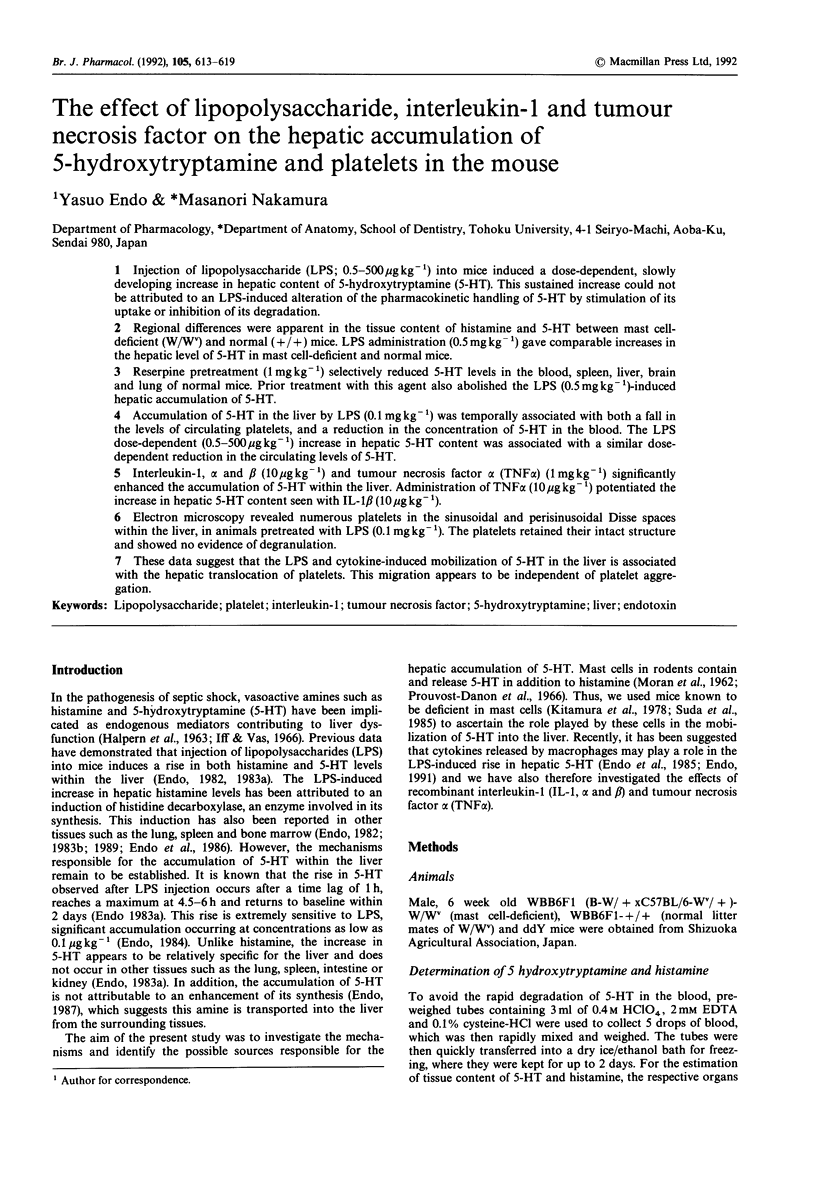
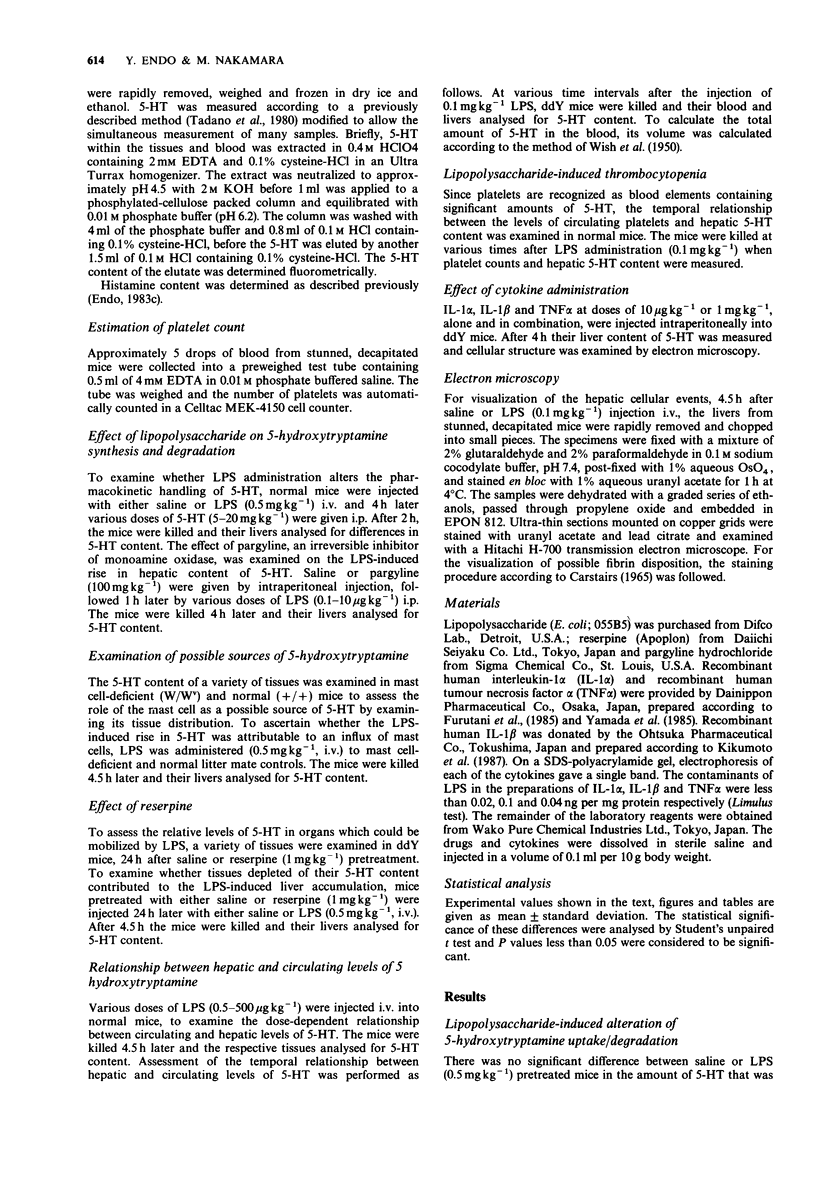
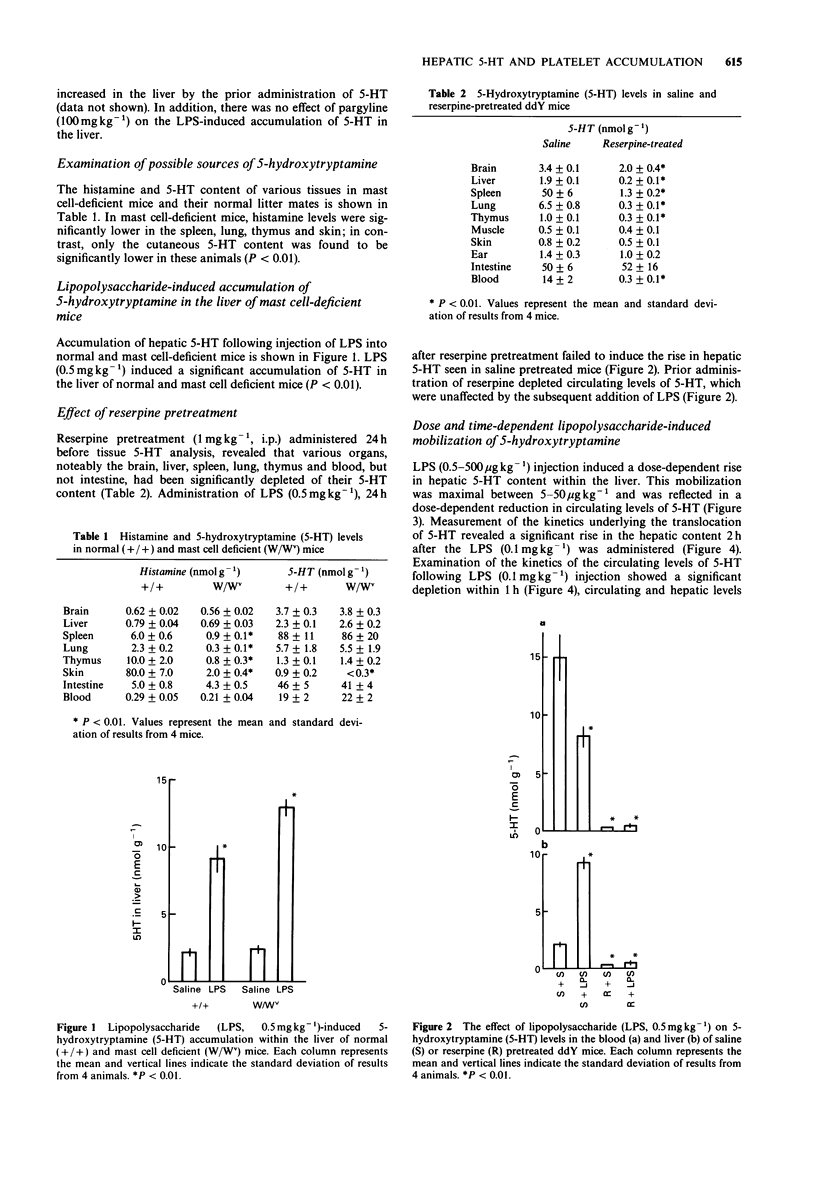
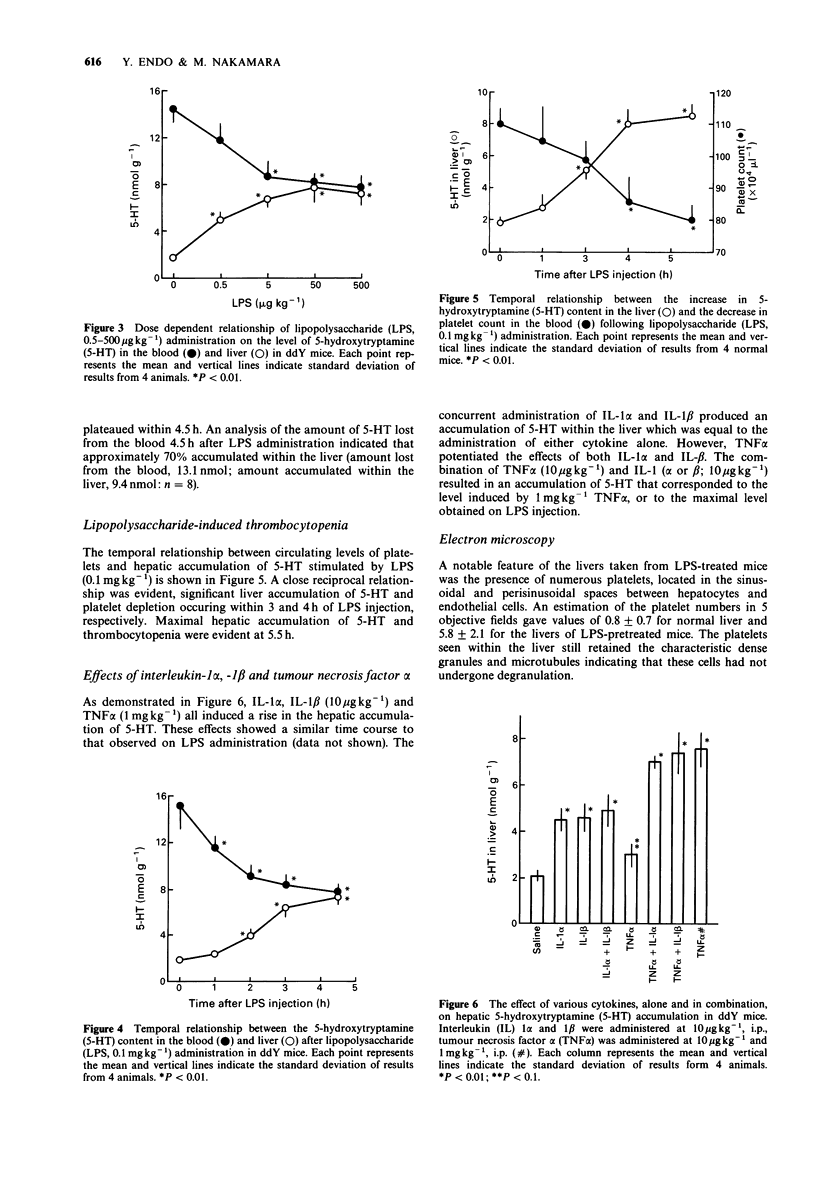
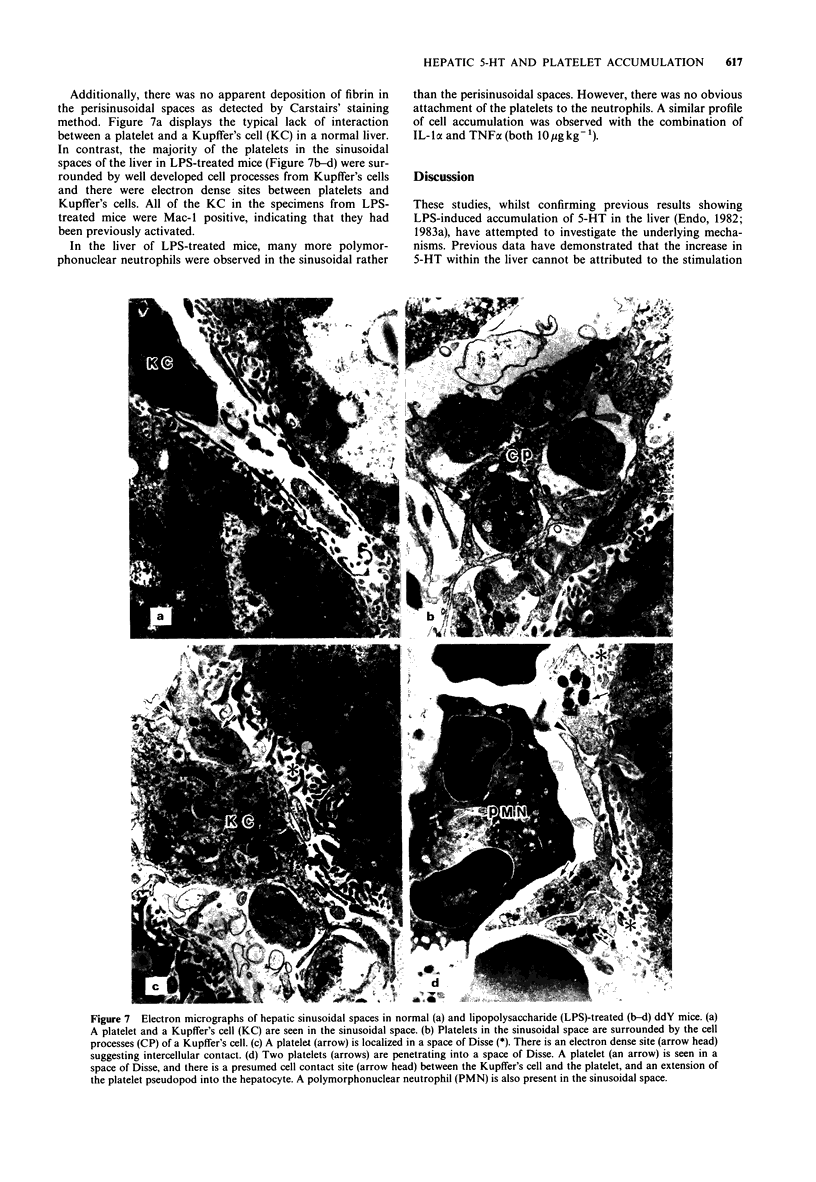
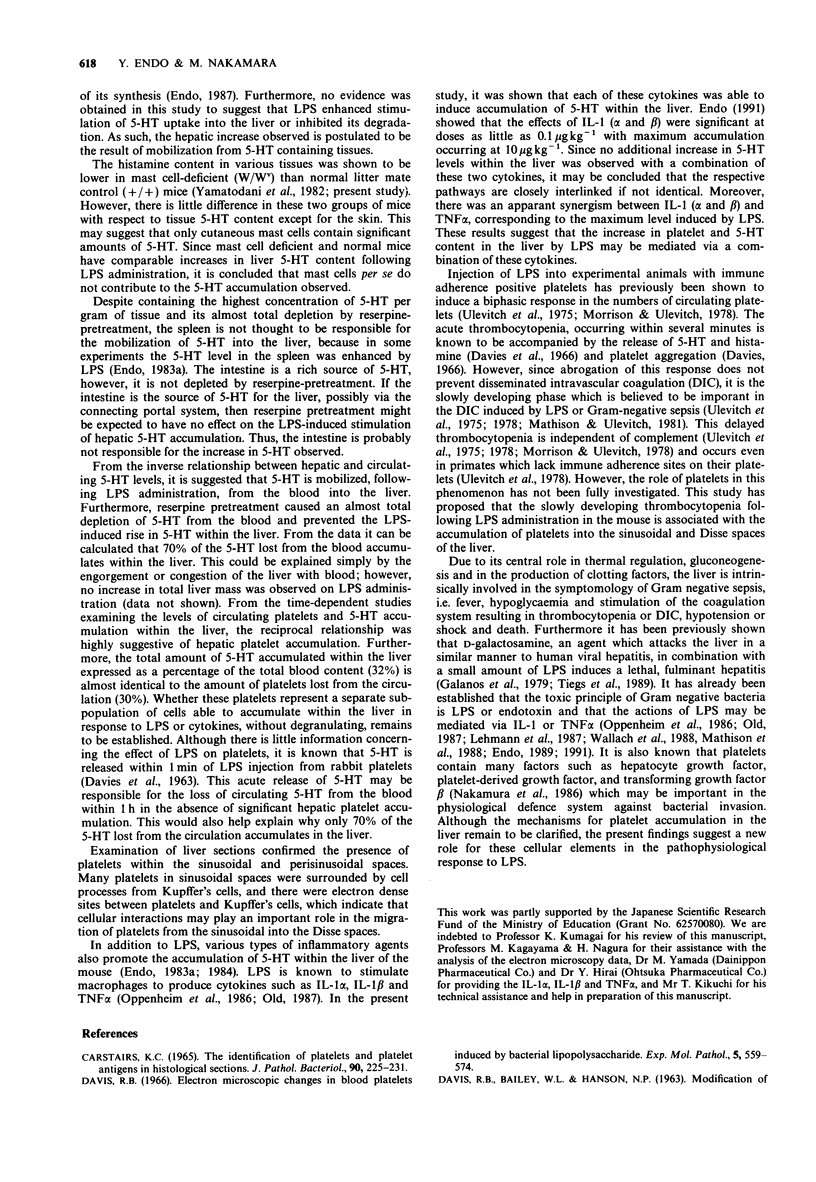
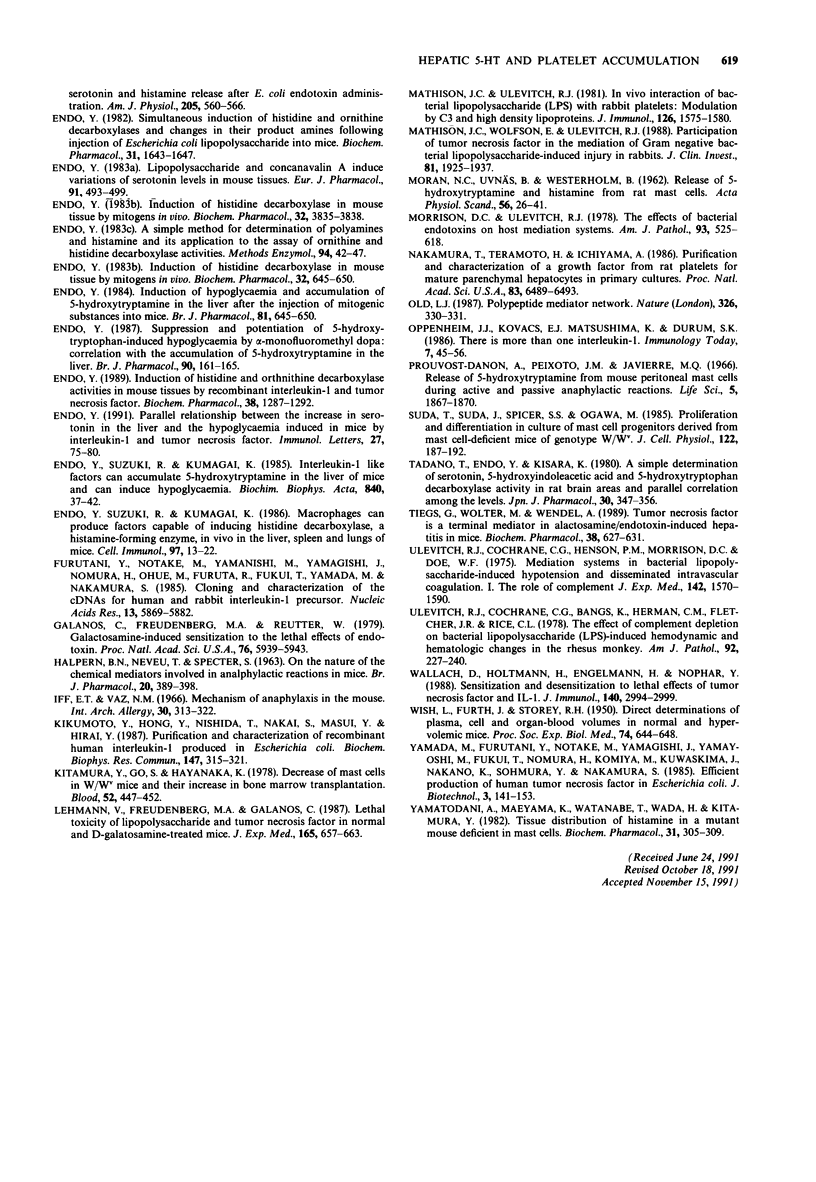
Images in this article
Selected References
These references are in PubMed. This may not be the complete list of references from this article.
- Carstairs K. C. The identification of platelets and platelet antigens in histological sections. J Pathol Bacteriol. 1965 Jul;90(1):225–231. doi: 10.1002/path.1700900124. [DOI] [PubMed] [Google Scholar]
- DAVIS R. B., BAILEY W. L., HANSON N. P. MODIFICATION OF SEROTONIN AND HISTAMINE RELEASE AFTER E. COLI ENDOTOXIN ADMINISTRATION. Am J Physiol. 1963 Sep;205:560–566. doi: 10.1152/ajplegacy.1963.205.3.560. [DOI] [PubMed] [Google Scholar]
- Davis R. B. Electron microscopic changes in blood platelets induced by bacterial lipopolysaccharide. Exp Mol Pathol. 1966 Dec;5(6):559–574. doi: 10.1016/0014-4800(66)90046-3. [DOI] [PubMed] [Google Scholar]
- Endo Y. A lipopolysaccharide and concanavalin A induce variations of serotonin levels in mouse tissues. Eur J Pharmacol. 1983 Aug 5;91(4):493–499. doi: 10.1016/0014-2999(83)90175-9. [DOI] [PubMed] [Google Scholar]
- Endo Y. A simple method for the determination of polyamines and histamine and its application to the assay of ornithine and histidine decarboxylase activities. Methods Enzymol. 1983;94:42–47. doi: 10.1016/s0076-6879(83)94008-9. [DOI] [PubMed] [Google Scholar]
- Endo Y. Induction of histidine and ornithine decarboxylase activities in mouse tissues by recombinant interleukin-1 and tumor necrosis factor. Biochem Pharmacol. 1989 Apr 15;38(8):1287–1292. doi: 10.1016/0006-2952(89)90335-3. [DOI] [PubMed] [Google Scholar]
- Endo Y. Induction of histidine decarboxylase in mouse tissues by mitogens in vivo. Biochem Pharmacol. 1983 Dec 15;32(24):3835–3838. doi: 10.1016/0006-2952(83)90157-0. [DOI] [PubMed] [Google Scholar]
- Endo Y. Induction of hypoglycaemia and accumulation of 5-hydroxytryptamine in the liver after the injection of mitogenic substances into mice. Br J Pharmacol. 1984 Apr;81(4):645–650. doi: 10.1111/j.1476-5381.1984.tb16130.x. [DOI] [PMC free article] [PubMed] [Google Scholar]
- Endo Y. Parallel relationship between the increase in serotonin in the liver and the hypoglycaemia induced in mice by interleukin-1 and tumour necrosis factor. Immunol Lett. 1991 Jan;27(1):75–79. doi: 10.1016/0165-2478(91)90248-9. [DOI] [PubMed] [Google Scholar]
- Endo Y. Simultaneous induction of histidine and ornithine decarboxylases and changes in their product amines following the injection of Escherichia coli lipopolysaccharide into mice. Biochem Pharmacol. 1982 Apr 15;31(8):1643–1647. doi: 10.1016/0006-2952(82)90394-x. [DOI] [PubMed] [Google Scholar]
- Endo Y. Suppression and potentiation of 5-hydroxytryptophan-induced hypoglycaemia by alpha-monofluoromethyldopa: correlation with the accumulation of 5-hydroxytryptamine in the liver. Br J Pharmacol. 1987 Jan;90(1):161–165. doi: 10.1111/j.1476-5381.1987.tb16836.x. [DOI] [PMC free article] [PubMed] [Google Scholar]
- Endo Y., Suzuki R., Kumagai K. Interleukin 1-like factors can accumulate 5-hydroxytryptamine in the liver of mice and can induce hypoglycaemia. Biochim Biophys Acta. 1985 May 29;840(1):37–42. doi: 10.1016/0304-4165(85)90159-x. [DOI] [PubMed] [Google Scholar]
- Endo Y., Suzuki R., Kumagai K. Macrophages can produce factors capable of inducing histidine decarboxylase, a histamine-forming enzyme, in vivo in the liver, spleen, and lung of mice. Cell Immunol. 1986 Jan;97(1):13–22. doi: 10.1016/0008-8749(86)90370-9. [DOI] [PubMed] [Google Scholar]
- Furutani Y., Notake M., Yamayoshi M., Yamagishi J., Nomura H., Ohue M., Furuta R., Fukui T., Yamada M., Nakamura S. Cloning and characterization of the cDNAs for human and rabbit interleukin-1 precursor. Nucleic Acids Res. 1985 Aug 26;13(16):5869–5882. doi: 10.1093/nar/13.16.5869. [DOI] [PMC free article] [PubMed] [Google Scholar]
- Galanos C., Freudenberg M. A., Reutter W. Galactosamine-induced sensitization to the lethal effects of endotoxin. Proc Natl Acad Sci U S A. 1979 Nov;76(11):5939–5943. doi: 10.1073/pnas.76.11.5939. [DOI] [PMC free article] [PubMed] [Google Scholar]
- HALPERN B. N., NEVEU T., SPECTOR S. On the nature of the chemical mediators involved in anaphylactic reactions in mice. Br J Pharmacol Chemother. 1963 Jun;20:389–398. doi: 10.1111/j.1476-5381.1963.tb01477.x. [DOI] [PMC free article] [PubMed] [Google Scholar]
- Iff E. T., Vaz N. M. Mechanisms of anaphylaxis in the mouse. Similarity of shock induced by anaphylaxis and by mixtures of histamine and serotonin. Int Arch Allergy Appl Immunol. 1966;30(4):313–322. doi: 10.1159/000229815. [DOI] [PubMed] [Google Scholar]
- Kikumoto Y., Hong Y. M., Nishida T., Nakai S., Masui Y., Hirai Y. Purification and characterization of recombinant human interleukin-1 beta produced in Escherichia coli. Biochem Biophys Res Commun. 1987 Aug 31;147(1):315–321. doi: 10.1016/s0006-291x(87)80123-7. [DOI] [PubMed] [Google Scholar]
- Kitamura Y., Go S., Hatanaka K. Decrease of mast cells in W/Wv mice and their increase by bone marrow transplantation. Blood. 1978 Aug;52(2):447–452. [PubMed] [Google Scholar]
- Lehmann V., Freudenberg M. A., Galanos C. Lethal toxicity of lipopolysaccharide and tumor necrosis factor in normal and D-galactosamine-treated mice. J Exp Med. 1987 Mar 1;165(3):657–663. doi: 10.1084/jem.165.3.657. [DOI] [PMC free article] [PubMed] [Google Scholar]
- Mathison J. C., Ulevitch R. J. In vivo interaction of bacterial lipopolysaccharide (LPS) with rabbit platelets: modulation by C3 and high density lipoproteins. J Immunol. 1981 Apr;126(4):1575–1580. [PubMed] [Google Scholar]
- Mathison J. C., Wolfson E., Ulevitch R. J. Participation of tumor necrosis factor in the mediation of gram negative bacterial lipopolysaccharide-induced injury in rabbits. J Clin Invest. 1988 Jun;81(6):1925–1937. doi: 10.1172/JCI113540. [DOI] [PMC free article] [PubMed] [Google Scholar]
- Nakamura T., Teramoto H., Ichihara A. Purification and characterization of a growth factor from rat platelets for mature parenchymal hepatocytes in primary cultures. Proc Natl Acad Sci U S A. 1986 Sep;83(17):6489–6493. doi: 10.1073/pnas.83.17.6489. [DOI] [PMC free article] [PubMed] [Google Scholar]
- Old L. J. Tumour necrosis factor. Polypeptide mediator network. 1987 Mar 26-Apr 1Nature. 326(6111):330–331. doi: 10.1038/326330a0. [DOI] [PubMed] [Google Scholar]
- Prouvost-Danon A., Peixoto J. M., Javierre M. Q. Release of 5-hydroxytryptamine from mouse peritoneal mast cells during active and passive anaphylactic reactions. Life Sci. 1966 Oct;5(20):1867–1870. doi: 10.1016/0024-3205(66)90281-5. [DOI] [PubMed] [Google Scholar]
- Suda T., Suda J., Spicer S. S., Ogawa M. Proliferation and differentiation in culture of mast cell progenitors derived from mast cell-deficient mice of genotype W/Wv. J Cell Physiol. 1985 Feb;122(2):187–192. doi: 10.1002/jcp.1041220204. [DOI] [PubMed] [Google Scholar]
- Tadano T., Endo Y., Kisara K. A simple determination of serotonin, 5-hydroxyindoleacetic acid and 5-hydroxytryptophan decarboxylase activity in rat brain areas and parallel correlation among the levels. Jpn J Pharmacol. 1980 Jun;30(3):347–356. doi: 10.1254/jjp.30.347. [DOI] [PubMed] [Google Scholar]
- Tiegs G., Wolter M., Wendel A. Tumor necrosis factor is a terminal mediator in galactosamine/endotoxin-induced hepatitis in mice. Biochem Pharmacol. 1989 Feb 15;38(4):627–631. doi: 10.1016/0006-2952(89)90208-6. [DOI] [PubMed] [Google Scholar]
- Ulevitch R. J., Cochrane C. G., Bangs K., Herman C. M., Fletcher J. R., Rice C. L. The effect of complement depletion on bacterial lipopolysaccharide (LPS)-induced hemodynamic and hematologic changes in the Rhesus monkey. Am J Pathol. 1978 Jul;92(1):227–240. [PMC free article] [PubMed] [Google Scholar]
- Ulevitch R. J., Cochrane C. G., Henson P. M., Morrison D. C., Doe W. F. Mediation systems in bacterial lipopolysaccharide-induced hypotension and disseminated intravascular coagulation. I. The role of complement. J Exp Med. 1975 Dec 1;142(6):1570–1590. doi: 10.1084/jem.142.6.1570. [DOI] [PMC free article] [PubMed] [Google Scholar]
- WISH L., FURTH J., STOREY R. H. Direct determinations of plasma, cell, and organ-blood volumes in normal and hypervolemic mice. Proc Soc Exp Biol Med. 1950 Jul;74(3):644–648. doi: 10.3181/00379727-74-18003. [DOI] [PubMed] [Google Scholar]
- Wallach D., Holtmann H., Engelmann H., Nophar Y. Sensitization and desensitization to lethal effects of tumor necrosis factor and IL-1. J Immunol. 1988 May 1;140(9):2994–2999. [PubMed] [Google Scholar]
- Yamatodani A., Maeyama K., Watanabe T., Wada H., Kitamura Y. Tissue distribution of histamine in a mutant mouse deficient in mast cells: clear evidence for the presence of non-mast-cell histamine. Biochem Pharmacol. 1982 Feb 1;31(3):305–309. doi: 10.1016/0006-2952(82)90175-7. [DOI] [PubMed] [Google Scholar]



